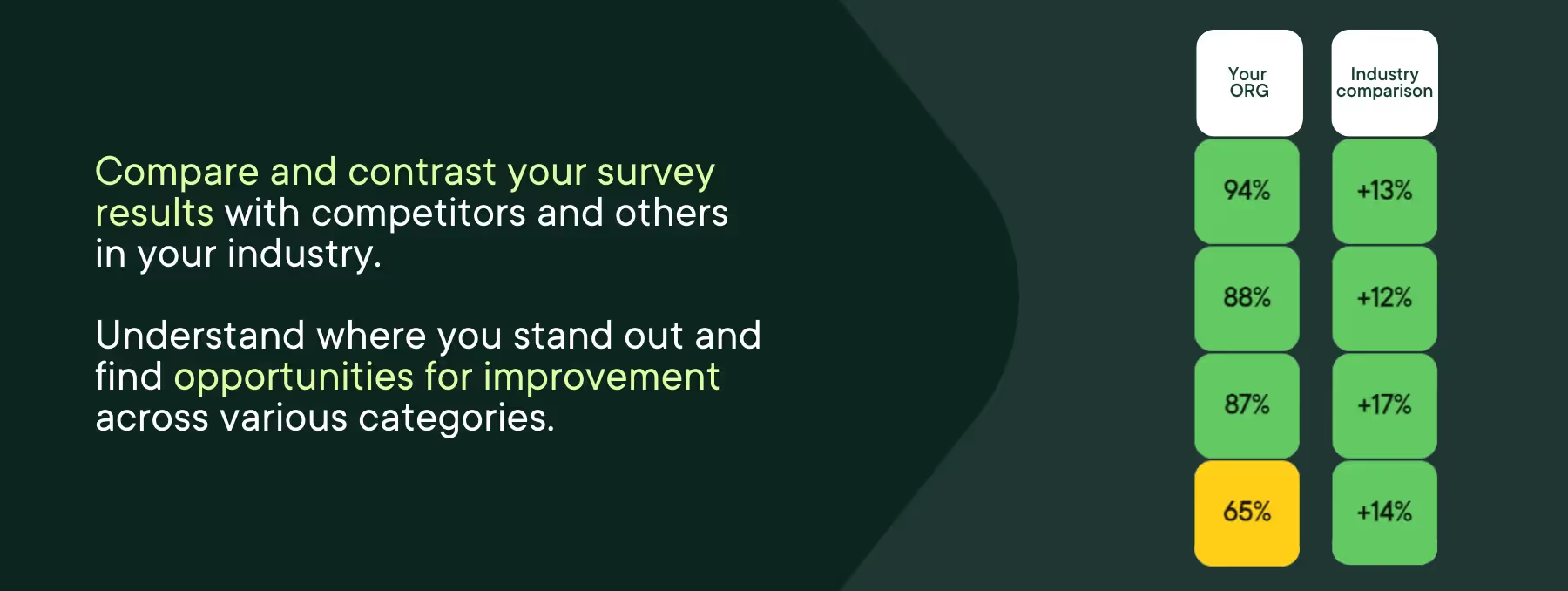


Give your people a voice with a tailored Xref Engage survey.
Increase retention and reduce turnover with quick employee feedback from an Xref Pulse Survey.
It can be valuable for all organisations – whatever their size, industry or geography – to measure employee engagement via surveys to find out how their employees really feel about their jobs and the company culture.
Surveying employees and analysing feedback helps human resources (HR) to spot trends and patterns in attrition and make changes to improve retention. To make the data work even harder, results can also be benchmarked.
This blog will outline what benchmarking is and why it’s important, examples of areas that can be benchmarked, and best-practice tips.
Benchmarking is where certain metrics are measured against industry standards. It is a great tool for seeing how an organisation stacks up against its competitors and industry peers and for identifying opportunities for improvement. Metrics could also be internal and compared to previous year’s results.
Benchmarking helps to make sense of business performance metrics as it contextualises them. By understanding how an organisation performs compared to its competitors, it’s easier to visualise goals and set realistic expectations (e.g. an industry average engagement score they want to achieve). A clear vision can then be communicated to employees and other stakeholders.
Benchmarking involves the practice of using metrics as a reference point to compare performance, whereas metrics like key performance indicators (KPIs) measure performance against objectives.
There are multiple types of benchmarking. When it comes to benchmarking employee survey results, organisations typically leverage internal and external (competitive) benchmarks.
External (competitive) benchmarking: Organisations check how they stack up against industry peers and provide insight on how to gain a competitive edge. Organisations may access industry benchmarks from survey providers or public records from similar organisations and sectors.
Internal (peformance) benchmarking: Organisations can compare their performance to their own historical data, such as data collected from previous surveys. Internal benchmarking is simple to do as data is within the organisation’s control.
Xref’s new solution Engage Surveys has strong industry benchmarks. Xref Engage is a market-leading survey solution built by workplace psychologists based on over 300 research papers, articles and case studies. With Xref Engage, organisations can easily compare and contrast survey results to competitors and identify opportunities for improvement.

Organisations can benchmark specific business areas depending on their priorities. Whatever the type of benchmark, it can help to make sense of the results.
For example, an organisation may conduct an engagement survey and find that 45% of employees say they feel empowered in their role. Without benchmarking that metric, how can the organisation be sure whether 45% is good or bad? Benchmarking can provide helpful context to inform how an organisation approaches that metric and the questions they ask in their future engagement surveys.
Another example is benchmarking survey participation rates. A 97% participation rate may look like your employees are highly engaged, but the industry standard may be much lower. The organisation may then consider why theirs is so high and whether the survey results are actually indicative of engagement. Perhaps the survey participation was mandatory, and employees sped through the survey because they had to and not because they were concerned with giving thoughtful feedback.
Benchmarking against historical survey results is also useful when implementing a change initiative, as it can track the progress and impact on employee engagement. For example, an organisation may aim to improve diversity, equity and inclusion (DEI) within the organisation and implement several activities over a two-year period. Throughout the process, HR may administer engagement surveys to measure the perception of the employer and attribute improvements to the changes made.

Benchmarking employee engagement survey data is key to understanding how employees perceive your organisation and their role. Below are three tips for getting the most out of benchmarks.
Benchmarking is a data-driven process that helps organisations to determine whether key areas of their business are successful, e.g. engagement levels.
In Xref Engage Surveys, this process is simple. The benchmarking functionality can provide a snapshot of how an organisation compares to similar organisations regarding employee experience, work environment, leadership, onboarding and more.
Visualising the data allows an organisation to set standards and expectations to improve retention over time. In turn, this can lead to a culture of continuous improvement, improving employee engagement for better business outcomes.
Find out more about Xref Engage by booking a free demo today.
